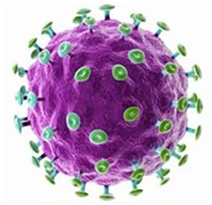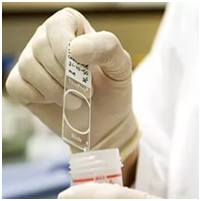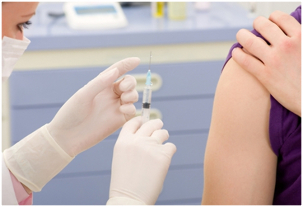
The human papilloma virus (HPV) is an important cause of morbidity and mortality in the world. Today, it is one of the virus the most common sexually transmitted diseases. The threat of virus infection vulnerable to a large part of the population of different ages.
Each tenth of people on the planet infected with this virus.
Some types of disease related to HPV have a negative impact on the reproductive function of women. Celebrated mass for the identification of new cases of oncology of the female reproductive system, related to infection by hpv.
Of the story.
The lesions of the skin and mucous membranes are known to the humanity already more than a millennium. Under the name of "condyloma" they have been described by the physicians of Ancient Greece. A particular interest of infection acquired at the end of the TWENTIETH century. The viral nature of warts has been proven at the beginning of the last century, the sexuality, the modalities of transmission have been recorded in 1954
The frequency of the condylomatosis in people young and middle-aged:
- 1981-1986 a - 5.4 per cent
- 1987-1999 a - 19,1%
- currently, up to 60%.
What is human papillomavirus infection?
The human papillomavirus (hpv) infection is a chronic viral disease, a disease from man to man sexually.
The causative agent of the infection.
The causative agent of the disease -the human papilloma virus (HPV) is the common name for more than 80 types of viruses, causing a variety of diseases of the skin and mucous membranes of the body. Each HPV virus has its serial number.

The human papilloma virus is detected:
- on the skin
- the mucous membranes of the mouth
- the mucous membranes of the conjunctiva
- the lining of the esophagus
- the mucosa of the bronchi, larynx
- the mucous membrane of the rectum
- the mucosa of the genitals
The transmission of the virus.
The transmission occurs only from person to person. The main route of transmission is sexual.
Are also possible:
- contact-household a route of transmission of infection in the presence of the UN epithelium - the virus can enter the body through scratches and abrasions, the virus has infected the human remains in the bathroom, gym, swimming pool, towel, razor
- the medical staff can be contaminated by the inhalation of dust during the removal laser genital warts, and infect through the surgical toolbox
- the transmission from mother to child during pregnancy
The factors contributing to the onset or recurrence of a HPV:
- Hypothermia
- Hormonal disorders
- Medical Manipulations (abortion, the introduction of an intra-uterine device)
- Pregnancy
Group of PAPILLOMAVIRUS infections
- The HPV does not cause cancer (warts on the pidermes)
- HPV low-risk cancer (different types of warts on the genitals)
- high high-risk (tumors in women and men)
The prevalence of HPV-associated diseases in the world
- 21 000 - Cancer of the vulva and vagina (In women)
- 40 000 - cancer of the anus (In men)
- 60 000 - Anal cancer (In women)
- The 530,000 - Cancer of the cervix (In women)
- 17 300 000 - condylomata acuminata In men
- 14 700 000 - condylomata acuminata (women)
The incubation period of hpv infection can last from 2 months to 2 years to 10 years, average of 3 months.
For the infection by hpv is characteristic hidden during.
The clinical picture.
Course of different infections. It may disappear spontaneously, and then again advance.
Distinguishes 3 forms of the disease:
- clinical - visible, papillom
- subclinical - the absence of visible manifestations, asymptomatic, reveals only the investigation (colposcopy or the study of cells)
- silent only determined by analysis of blood
The main symptoms of hpv infection is the appearance of:
- warts;
- papillom - soft tumours which attach themselves to the skin, thanks to the rod;
- genital warts - growths with rough surface (mainly appear around the anus and the genitals).
It is to these symptoms, you need to be careful in the first place.
The consequences of infection with the human papillomavirus:
- Cancer of the cervix is the second cause of mortality among women. The life expectancy of the sick women fell by an average of 26 years. It is proven that 70% of the cases of cancer of the cervix caused by HPV 16 and 18 types.
- Cancer of the cervix is fully is a preventable disease, if it is an early cancer or pre cancer.
- Cancer of the vulva and vagina.
- The anal cancer. Each year around 100,000 cases of this type of cancer.
- Cancer of the penis. Called in 35% of cases, HPV 16 and 18 HPV 6 and 11-5% of the cases.
- The anogenital region of the wart. Are called by the HPV 6 and 11. According to the WHO, each year in the world recorded more than 30 million cases of sexually transmitted diseases warts.
- The cancer zone oropharyngeal among young men.
How to determine the presence of the virus in the body and of its type?

In most cases, the infection is asymptomatic, so that the virus in the patient is generally detected only with the help of a special analysis.
The diagnosis of HPV can include:
- clinical examination of the patient;
- the screening of the cervix;
- Polymerase chain reaction (PCR) is an effective method for the diagnosis, with which you can determine the type of virus;
- examination under the microscope studied the nature of the cells (cervical cytology of the cervix);
- a blood test for the detection of antibodies to HPV (this method is very rarely used);
- the biopsy in the time of the procedure of the "suspicious location" (for example, genital warts, or papillom) take particles of tissue. Is appointed, if there is a suspicion that the patient has cancer.
What is the pap test?
This is a test to identify pre-cancerous or cancerous cells of the vagina and cervix of the uterus. With the surface of the cervix of the uterus, or of a special channel of the spatula is withdrawn. Taken, the material is applied on the glass and sent to the laboratory, where technicians carefully examine the structure. The test is named after the Greek scientist George Papanicolaou.

When and to whom you must pass a Pap test?
- Cytological smears need to spend every woman at least once a year from 18 years of age or the beginning of the sexual life. In case of absence of sexual contacts, the analysis is valid 1 time in 3 years.
- Twice a year, a cytological smear is recommended during the use of hormonal contraception, as well as women who suffer from genital herpes.
- The pretext for the more frequent studies cytology are common in the female sexual partners, being overweight (obesity), infertility, the presence of genital warts genital.
The prevention of infection by hpv.
Given the particular danger of this infection, a lack of efficacy of existing treatments, the priority acquires the prevention of this infectious disease.
Non-prevention:
- the sexual education of adolescents
- limiting the number of sexual partners
- the use of a condom reduces the risk of transmission of HPV
- cervical screening, which represents a regular inspection of women with the help of a Pap test (smear from the cervix) for the rapid detection and treatment of pathologies
- quit smoking
The specific prevention:

Vaccination against the most dangerous oncogenic) types of HPV boys and girls aged 12-13 years before the beginning of sexual life, and the potential contact with HPV. After the vaccination, which is formed of the immunity.
Why is a vaccine against infection by hpv?
The human papilloma virus cause a degeneration of the cells, which are the cause of cancers, including cancer of the cervix.
In recent years, the rapid growth of the frequency of cancers in men, and that more and more often the question of the introduction of vaccination against HPV for both sexes.
Currently, the HPV vaccine included in the immunization schedule in 57 countries around the world, six of them introduced the vaccination of both sexes.
The effectiveness of the vaccination reached 98-100%, which has been proven by clinical studies.
The HPV vaccination is most effective before the beginning of the sexual life, but it is recommended that all young women.
The implementation of a large vaccination campaign will prevent 80-82% of all the tumors in this group.
The prevention of hpv infection is an essential component in the prevention of cancer of the cervix in women, and certain types of cancer in men.
























